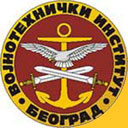 |
SCIENTIFIC-TECHNICAL INFORMATION Military Technical Institute Belgrade |
|||
|
SERBIA |
FRANCIA |
|||

|
INTEGRATED TRACK SPLITTING METHOD FOR TARGETS TRACKING
Dr Zvonko Radosavlјević Prof. dr Branko Kovačević
Abstract: It is known that sensors provide the measurement whose results can be effectively used for evaluation (estimation) of the parameters and state of the system. In most cases, the exact source of measurement is known, thus estimation is performed by using standard methods (Kalman-Bucy filter). Data association is necessary in scenarios where source of measurements is not known, such as the observation of radar or sonar. ITS filter recursively calculates the probability of the existence for each track in each scan and this is used to discriminate false tracks. History of the tracks components affects the accuracy of tracking, especially at low probabilities of targets detection. The lack of theoretical and practical comparisons between various depth history of tracks components, is one of the problems that arise in practical applications of moving targets tracking. The relationship between FTD and control of components is a part of the research, which should result in practical guidelines for the use of ITS filter. Estimation of each component is the output of the filter that gives one measurement at each scan. Representative of each component is the history of belonging of the measured track to target, expressed through the appropriate probabilities. Because they are mutually exclusive, the sum of the probability of all track components equals „one“. Each state of component consists of the probability of existence and pdf of component state estimation, provided that the component exists. Thus, each new measurement, paired with the component from the previous scan, provides a new component. Each ITS track recursively updates every scan. The probability of the track existence is used to confirm or decline all tracks generated in the consequent scans. The effect of clutter leads to some errors when acknowledging the tracks. Some of the confirmed tracks can be false. The result of the FTD process is to „confirm“ оr „terminate“ some tracks. Track trajectory pdf is approximated by a number of tracks components (Gaussian). This approximation is due to the control of tracks components. Improving approximation trajectories results with an improvement of FTD performance and increases the number of „retained“ components with increasing computational demands. Compromise between FTD and available computing resources is an additional aim of the analisys. Having theoretical and practical comparison of different depths of history of ITS algorithms in mind, it is necessary to determine their formation and contract, the mutual constraints. All known methods for tracking targets (Probabilistic Data Association-PDA, Multiple Hipothesys Testing-MHT, Probability Hipothesys Density-PHD, ...) deal exclusively with the reduction of the tracking error across all the coordinates of the state vector, but do not use qualitative and quantitative track testing. In other words, the track is identified with the target, although they do not have quantitative indicator for this claim. ITS filter, for the first time in tracking algorithms, introduces a recursive calculation of the probability of existence of a trace, and thus becomes an effective method for automatic tracking of targets in the environment of a dense cluster. Practical instructions to the user for the application of this algorithm have not been published so far and are the subject of the study. The subject of the study is also to explore the possibility of applying the monitoring of moving targets by the method of combining trace components in different scenarios of target movement and with different clutter densities. In addition, the aim of the study is to define the problem of data association that can be solved by the method of combining track components.
Key words: target tracking, automatic tracking, state estimation, Kalman filter, PHD filter, algorithms, radar track splitting.
|